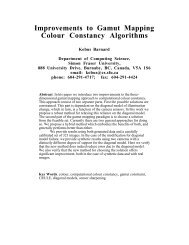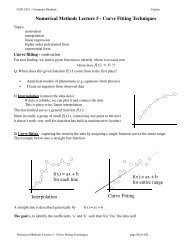4 1. INTRODUCTIONFigure 1.2 Plot of a training data set of N =10 points, shown as blue circles,each comprising an observationof the input variable x along withthe corresponding target variablet. The green curve shows thefunction sin(2πx) used to generatethe data. Our goal is to predictthe value of t for some newvalue of x, without knowledge ofthe green curve.1t0−10x1detailed treatment lies beyond the scope of this book.Although each of these tasks needs its own tools and techniques, many of thekey ideas that underpin them are common to all such problems. One of the maingoals of this chapter is to introduce, in a relatively informal way, several of the mostimportant of these concepts and to illustrate them using simple examples. Later inthe book we shall see these same ideas re-emerge in the context of more sophisticatedmodels that are applicable to real-world pattern recognition applications. Thischapter also provides a self-contained introduction to three important tools that willbe used throughout the book, namely probability theory, decision theory, and informationtheory. Although these might sound like daunting topics, they are in factstraightforward, and a clear understanding of them is essential if machine learningtechniques are to be used to best effect in practical applications.1.1. Example: Polynomial Curve FittingWe begin by introducing a simple regression problem, which we shall use as a runningexample throughout this chapter to motivate a number of key concepts. Supposewe observe a real-valued input variable x and we wish to use this observation topredict the value of a real-valued target variable t. For the present purposes, it is instructiveto consider an artificial example using synthetically generated data becausewe then know the precise process that generated the data for comparison against anylearned model. The data for this example is generated from the function sin(2πx)with random noise included in the target values, as described in detail in Appendix A.Now suppose that we are given a training set comprising N observations of x,written x ≡ (x 1 ,...,x N ) T , together with corresponding observations of the valuesof t, denoted t ≡ (t 1 ,...,t N ) T . Figure 1.2 shows a plot of a training set comprisingN =10data points. The input data set x in Figure 1.2 was generated by choosingvalues of x n , for n =1,...,N, spaced uniformly in range [0, 1], and the targetdata set t was obtained by first computing the corresponding values of the function
1.1. Example: Polynomial Curve Fitting 5sin(2πx) and then adding a small level of random noise having a Gaussian distribution(the Gaussian distribution is discussed in Section 1.2.4) to each such point inorder to obtain the corresponding value t n . By generating data in this way, we arecapturing a property of many real data sets, namely that they possess an underlyingregularity, which we wish to learn, but that individual observations are corrupted byrandom noise. This noise might arise from intrinsically stochastic (i.e. random) processessuch as radioactive decay but more typically is due to there being sources ofvariability that are themselves unobserved.Our goal is to exploit this training set in order to make predictions of the valuêt of the target variable for some new value ̂x of the input variable. As we shall seelater, this involves implicitly trying to discover the underlying function sin(2πx).This is intrinsically a difficult problem as we have to generalize from a finite dataset. Furthermore the observed data are corrupted with noise, and so for a given ̂xthere is uncertainty as to the appropriate value for ̂t. Probability theory, discussedin Section 1.2, provides a framework for expressing such uncertainty in a preciseand quantitative manner, and decision theory, discussed in Section 1.5, allows us toexploit this probabilistic representation in order to make predictions that are optimalaccording to appropriate criteria.For the moment, however, we shall proceed rather informally and consider asimple approach based on curve fitting. In particular, we shall fit the data using apolynomial function of the formy(x, w) =w 0 + w 1 x + w 2 x 2 + ...+ w M x M =M∑w j x j (1.1)where M is the order of the polynomial, and x j denotes x raised to the power of j.The polynomial coefficients w 0 ,...,w M are collectively denoted by the vector w.Note that, although the polynomial function y(x, w) is a nonlinear function of x, itis a linear function of the coefficients w. Functions, such as the polynomial, whichare linear in the unknown parameters have important properties and are called linearmodels and will be discussed extensively in Chapters 3 and 4.The values of the coefficients will be determined by fitting the polynomial to thetraining data. This can be done by minimizing an error function that measures themisfit between the function y(x, w), for any given value of w, and the training setdata points. One simple choice of error function, which is widely used, is given bythe sum of the squares of the errors between the predictions y(x n , w) for each datapoint x n and the corresponding target values t n , so that we minimizeE(w) = 1 2j=0N∑{y(x n , w) − t n } 2 (1.2)n=1where the factor of 1/2 is included for later convenience. We shall discuss the motivationfor this choice of error function later in this chapter. For the moment wesimply note that it is a nonnegative quantity that would be zero if, and only if, the





